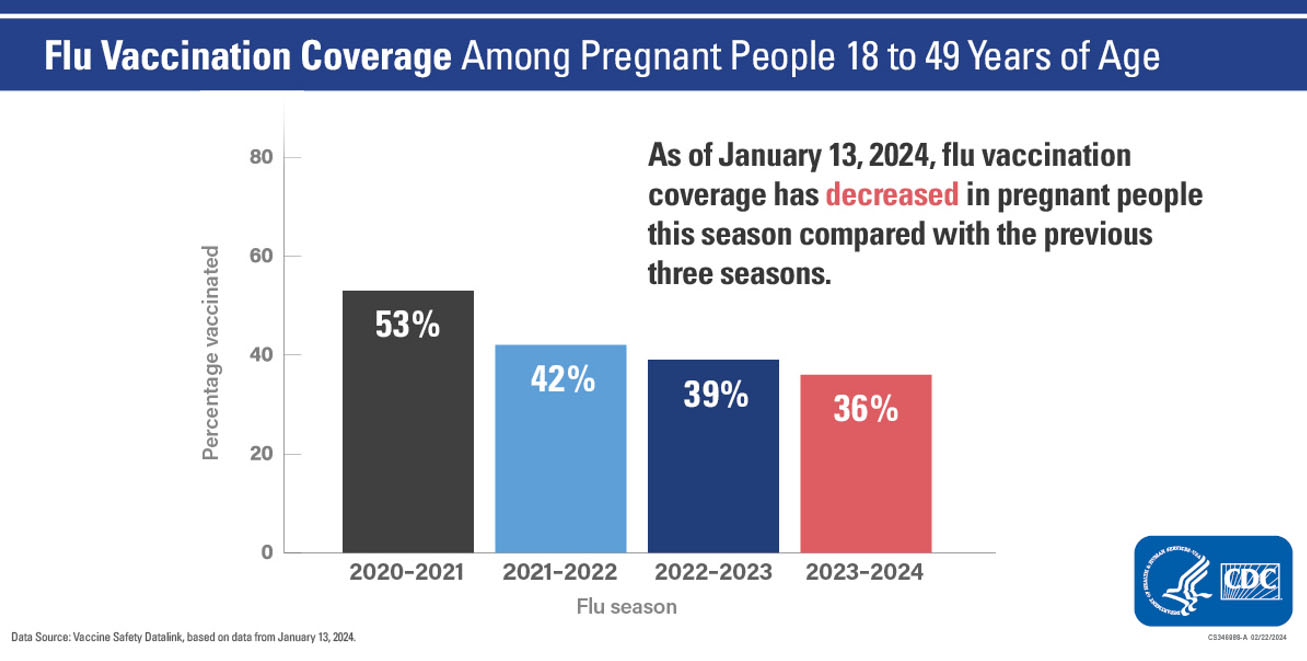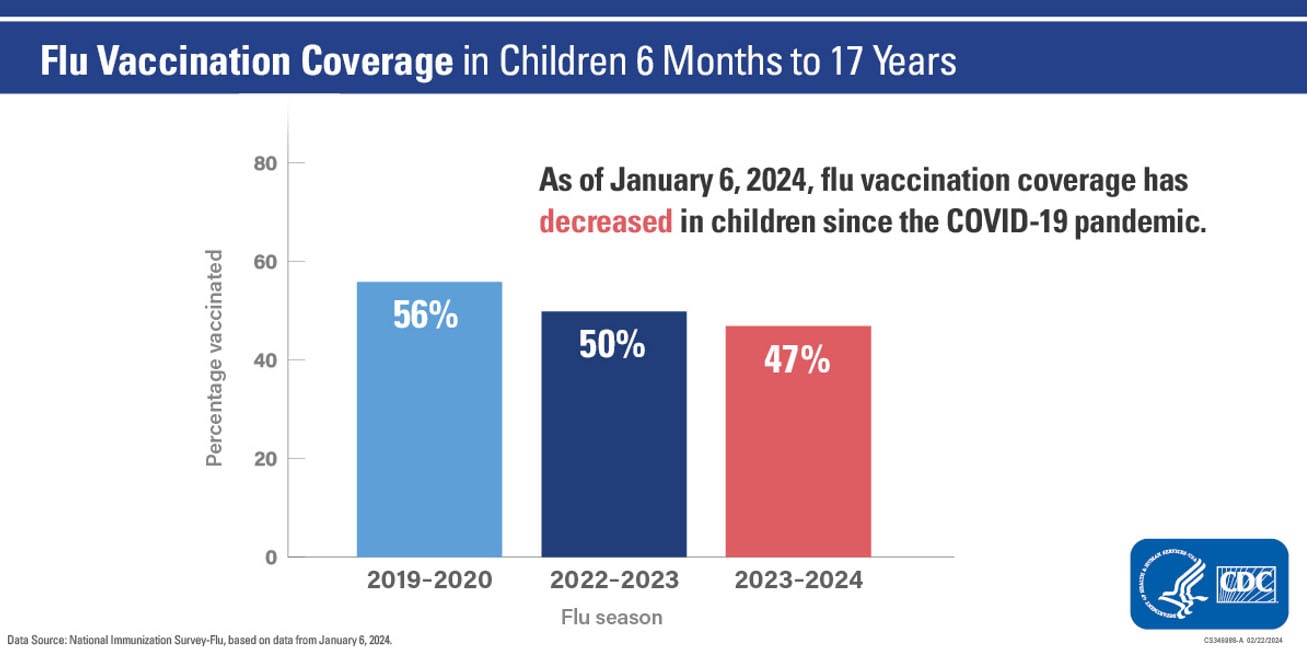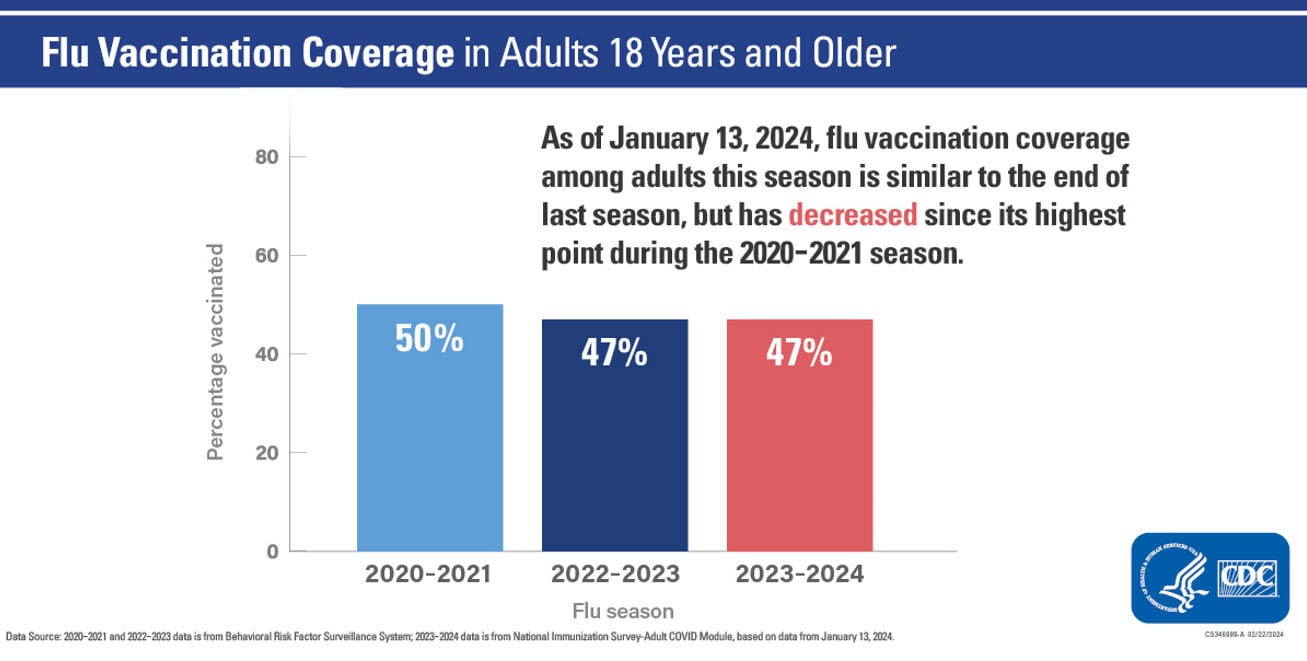At a glance
- This spotlight article was published on January 19, 2024.
- CDC’s flu vaccination estimates as of January 19, 2024, showed a drop in flu vaccine uptake among some groups of adults this season and a continued decline in flu vaccination coverage among pregnant people and children since 2020. Health care provider recommendations are important for increasing vaccine uptake among patients.
Overview
January 19, 2024 — CDC's flu vaccination coverage estimates updated on January 19, 2024, show a drop in flu vaccine uptake among some groups of adults this season, and a continued decline in flu vaccination coverage among pregnant people and children since 2020. With flu season ongoing in the United States, CDC continues to recommend flu vaccination, as well as early antiviral treatment for people with flu symptoms who are very sick (for example, hospitalized) or at higher risk of developing severe illness. Health care provider recommendations for and offers of vaccination are important to increasing vaccination uptake.
Pregnant people
Flu vaccination coverage among pregnant people continues to be lower this season compared to recent prior seasons. Based on data from January 13, 2024, flu vaccination coverage among pregnant people as of the end of December 2023 is:
- About 3 percentage points lower compared to the end of December 2022 (36% compared with 39%),
- About 6 percentage points lower compared to the end of December 2021 (36% compared with 42%), and
- 17 percentage points lower than at the end of December 2020 (36% compared with 53%).

These continued drops in flu vaccination coverage among pregnant people, who are at higher risk of developing serious flu complications, are very concerning, and have occurred despite additional outreach by CDC and partners to reverse this trend, including a public education campaign focusing on pregnant people this season.
Children
Overall flu vaccination coverage among children this season as of January 6, 2024, is about 47%. This is about 3 percentage points lower compared with the same time during December 2022 (50%). Coverage has dropped by about 9 percentage points since January 2020, before the COVID-19 pandemic (47% compared with 56%).
Coverage declines with age in children, with the lowest percentage vaccinated being the 12–17 age group (41%), followed by the 5–17 age group (45%), compared to the 6–23 months age group with a coverage rate of 60%.

Adults
Flu vaccine coverage for all adults is about 47%, which is similar to coverage among adults at the end of last season (2022–2023). The highest overall coverage among adults in the U.S. was during the 2020–2021 flu season, when end-of-season estimates were that 50% of the adult population had gotten a flu vaccine.
Coverage increases by age in adults, with the lowest coverage among adults 18 through 29 years (32%) and highest coverage for adults 75 years and older (80%). Adults 65 years and older are considered at higher risk of developing serious flu complications and coverage in that age group is typically highest every year. However, a decline in coverage in older adults was seen between the 2021–2022 and 2022–2023 seasons. In 2020–2021, an estimated 75% of adults 65 years and older got a flu vaccine. At the end of last season (2022–2023), CDC estimated coverage among people 65 years and older to be 70%. All age groups trended downwards in coverage from 2021–2022 to 2022–2023.

Flu activity update
Although some flu activity indicators showed declines in the past two weeks, flu activity remains elevated nationally. This week's FluView, which reports data for the week ending January 13, 2024, shows the number of specimens testing positive for influenza virus remained stable at 14%, while the number of weekly flu hospitalizations reported to CDC declined from 18,500 to 14,900. CDC estimates that there have been at least 16 million flu illnesses, 180,000 flu hospitalizations, and 11,000 deaths from flu so far this season.
CDC recommends flu vaccination as long as influenza viruses are spreading in the community. Everyone 6 months and older should get a flu vaccine each year for the best protection against flu. There's still time to benefit from the protection vaccination offers this season as flu activity is ongoing. With activity high at this time, CDC is also reinforcing the importance of flu treatment. Prescription flu antiviral drugs can treat flu illness and should be started as early as possible in patients who are severely ill or at higher risk of developing serious complications.
